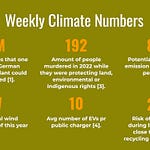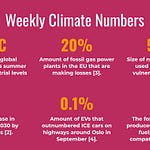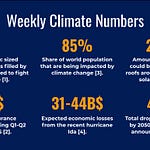Welcome to this weeks edition of The Weekly Climate! 🎉

I have spent some time in this and the past issues of this newsletter presenting the evidence for all the doom and gloom that we’re heading towards if we don’t solve the climate crisis. That is because I think an important part of this newsletter is reporting on what awaits us if we don’t solve it. However, something that in general is written very little about is what awaits us if do solve it. But why are both important? In 1940 the economist Ludwig von Mises wrote, that human action depends on three things being present:
Being dissatisfied with the present state
Having a vision of a better state
Belief that we can reach a better state
The doom and gloom news provide (1) and hopefully the detailed sections of this newsletter provide some of (3) by talking about what’s going on and what’s being done. But (2) is lacking. In the coming weeks I will try to paint a vivid picture of what a zero carbon world looks like. A world where the climate crisis is solved.
Spoiler alert: It’s going to be great! (both the posts and the zero carbon world 😅).
In meta news (news about the newsletter): I’ve decided to change the format a tiny bit. I’ve gotten mostly two great forms of feedback from you, my dear readers: (1) The newsletter is a tad long giant wall of text and (2) people really enjoy the full overview. So how do I reconcile both of these? I’m going to make the executive summary just a tad more detailed for those who want a quick overview and then keep the longer post below for those that want to dive in (or if you find something interesting in the executive summary that you want do understand better. Because of the longer summary, I have removed the “if you can only read one article this week” because the summary will obviously touch on the most important stuff this week. In addition, to make the longer version easier to read I’ve added a hashtag at the beginning of each post that describe the topic such that people can easier browse what they might and might not be interested in.
I still think that the podcast format is probably the better suited for the long post than the newsletter itself. So if you want the full overview, but don’t want to read a giant wall of text, have you tried the podcast instead? Let me know in the comments below or by e-mailing me.
🏃♂️💨The quick overview
For those in a hurry here we go:
U.S: California’s energy agencies exonerated renewable energy as the cause of the recent power outages. In addition, U.S. is hit hard by wild fires and fossil fuel fueled hurricanes this week.
Technology: Two exciting new technologies was revealed this week: (1) a new energy source that mimics photosynthesis and (2) a new battery that is self-charging. Yes you heard that right: Self-charging.
Startups: Two cool aircraft developments: (1) An infrastructure play to make it easier to deploy clean hydrogen powered aircraft, and (2) an electric airplane company is attempting to beat 7 world records. And a nuclear one: NuScale’s Small Modular Reactor (SMR) becomes the first SMR to get approval by the U.S. Nuclear Regulatory commission marking a big milestone for NuScale and SMRs in general.
Investment: ExxonMobil drops out of the Dow Jones Industrial Average index, where it has resided for more than 120 years.
Major Emitters: One good and one bad. Good: Fracking industry is really hurting, expecting almost 100 bankruptcies this year. Bad: Big oil in general is reducing their investments in renewable energy.
Climate Justice: George Monbiot slays the idea (once again) that population growth is to blame for climate change.
🐢The long overview
For those who want to dive deeper, brace yourselves, the long overview is coming.
🕵️♂️Stories we follow
California power outages amidst the heat waves. (Get an overview) California has experienced a series of rolling blackouts Aug 16 through 18 as a result of high power demand and a few mishaps. What we know is that power demand was high, but not higher than usual, when solar started to drop and a fossil gas power plant went unexpectedly offline. The role of the utilities like PG&E is particular interesting and horrifying after it became clear that PG&E and many other utilities have been fighting regulation that would have forced them to do more to prevent wildfires. A good thing for the energy transition though is, that renewables have been exonerated as the cause of the power outages by California’s energy agencys. In a letter to the governor they state unequivocally, that the outages was not caused by California’s commitment to clean energy. The state are taking expected measures to prevent this from happening again as California just signed off on 1.2GW of battery storage deployments.
U.S. Presidential Election. The U.S. is a major emitter and are run by a climate sceptic and fossil fuel friendly… person. We need a change. And after Joe Biden was elected as the democratic candidate that change has to be him. Hence we keep a close watch on his climate aspirations. A detailed article in VOX goes through all the things that Trump has done to try and accelerate climate change. In short, he has rolled back more than 100 regulations related to climate change and introducing regulation that will benefit the fossil fuel industry a lot. It is truly good news that voters take climate change more seriously. The Democratic party definitely leads in terms of climate action as they have even endorsed existing nuclear in their platform, whereas Republicans are doing absolutely nothing. Also be sure to check out this weeks episode of The Interchange and Energy Gang podcasts to follow up on Trump’s latest in his fight against climate action.
👩🔬Climate & Science
| #wildfires | — As one would expect climate scientists are not surprised by the severity of wildfires, extreme temperatures and extreme weather events as seen across the world currently. And there’s a lot of extreme weather events currently (check out the link for a complete overview just the last month). The fires are not just a problem for the California and Colorado where the big fires are burning, but also the rest of the country. However, it is pretty bad in Northern California as it was determined last week that they had the dirtiest air in the world. In addition, Covid19 is impacting fire response due to reduced amount of inmate fire fighters.
| #hurricanes | — Hurricane Laura made landfall last week. And that too is not surprising. Climate scientists have been saying for ages that global warming will increase hurricane frequency and intensity. As Emily Atkin put it Laura is Katrina on fossil fuel steroids. In fact a chemical plant just released a years worth of emissions as it had to restart after Laura passed. Fun thought: If we can make a fossil fuel company pay to clean up an oil spill for instance. Why aren’t they paying for other kinds of environmental damages, like hurricanes?
🤖Technology
| #energy | — Researchers have invented a new energy generation technology that takes carbon dioxide, sunlight and water and convert it into oxygen and formic acid. Formic acid can be used as a fuel either directly or can be turned into hydrogen.
| #energystorage | — And if you thought the previous technology sounded to good to be true then get this: A company called NDB have invented a nano-diamond self-charging 😳 battery. Yes self-charging. It can literally charge itself for 28.000 years. How? By getting rid of another energy sector problem: Nuclear waste 🤯. Mind. Blown. The technology is still far from commercialization, but color me excited.
| #windturbine | — An experimentment with painting a single wind turbine blade black has reduced the bird mortality rate to 72%. As a wildlife photographer who in particular enjoys bird photography this is obviously great news, but let’s not use this as an excuse to say that wind turbines takes a huge toll on bird mortality. For comparison cats kills 2.4B, vehicles 200M, buildings 600M where wind turbines are estimated to kill around 200.000. Now with this new “technology” that number is down to 60.000.
💡Startups
| #hydrogen | — A startup Universal Hydrogen led by former CTO of Airbus wants to enable hydrogen flight. And a key thing to doing that is to enable hydrogen fueling infrastructure. And the way they’re doing it is that they have built a way to easily load hydrogen fuel tanks into the aircraft, such that a truck can drive up to the aircraft, remove the empty tanks and insert new ones. Hereby making hydrogen fueling of aircraft safe, fast and probably most importantly, easy deployable.
| #virtualpowerplants | — Virtual Power Plants (VPPs) are coming to an apartment building near you. Sonnen, a german startup bought by Shell 🤨 in 2019, are launching a big project to build VPPs for 3000 apartments in San Francisco. VPPs are really interesting. The basic concept is that Sonnen sets up solar panels and batteries that supply your apartment with electricity. You can choose whether to use the power they generate or sell the power back to the grid or to other apartment members.
| #electric aircraft | — Pipistrel, small electric aircraft company, is attempting beat 7 world records with its Velis Electro aircraft with a flight of 700 km: Lowest energy consumption, highest average speed, highest flight altitude for electric aircraft, fastest climbing performance, fastest average speed, smallest number of intermediate stops, longest electrically flown route.
| #demandresponse | — Tibber, a swedish energy startup has for the first time been able to deliver 100KW bids into the electricy market via electric vehicle chargers. This is the first time in Europe that balancing services have been provided by residential electric vehicles at this scale. And as we discussed last time regarding California’s power outages this is a great way to do Demand Response to help balance the grid in case of unforeseen events as happened there.
| #nuclear | — Small Modular Reactors (SMRs) are a hot topic in nuclear. Some people claim that they’re poised to be easier and faster to deploy because they can be factory built and shipped out on trucks. Some claim that scaling the whole thing down don’t make any economic sense. Nonetheless NuScale’s SMR just became the first SMR to receive approval by the U.S. Nuclear Regulatory Commision. This is a big milestone for NuScale as it ultimately means that projects incorporating the SMR can go ahead. Following the interesting discussion last week in the Decouple podcast it’s going to be interesting to see what happens next. Now that the NuScale SMR is close to existing will it then be shunned?
💰Investing
| #stockmarket | — Some fantastic news although symbolic. ExxonMobil has been booted from the Dow Jones Industrial Average (DJIA)! Exxon is the company that has been on the DJIA the longest and has seen a tremendous drop in value: From 525B$ in 2007 to 450B$ in 2014 to 180B$ in 2020.
| #divestment | — Norways biggest asset manager Storebrand have divested shares in 21 companies that doesn’t comply with their new climate friendly investment policies. About forty seven million $ in total have been divested from companies such as Exxon, Chevron, ConocoPhillips, Taiwan Cement and more.
⛽️Major Carbon Emitters
| #bankruptcies | — Some good news. The fracking industry is hurting 💪. 36 companies have filed for bankruptcy in 2020 and they have amassed over 43B$ in debt. Some industry analysts expects 60-70 more companies to file before 2020. While a win for the climate crisis, it goes to show that there’s a big challenge coming with relocating and retraining all those people that are becoming unemployed as a result of the fall of the fossil fuel industry.
| #renewables | — Oilprice reports on 3 Big Oil companies that bet “big” on renewables. In total Big Oil pledges to spend 16B$ on renewable energy projects over the next 5 years, which is about 8% of the budget they plan to spend on fossil fuel production. More than 50% of those 16B$ comes from one company: Equinor. In fact, if one removed Equinor from the equation, big oil would reduce their spending on renewable energy projects.
| #banks | — This post by Citi Banks CEO on CNN was so infuriating that I feel forced to add Citi Bank to my list of Major Carbon Emitter news. In it he acknowledges the need to get rid of the fossil fuel industry but at the same time says that they will continue to support them. What is he not getting FFS?! The banks has got to walk the walk and this post just goes to show that Citi Bank are not doing that. If you have Citi Bank and want to switch, checkout Banking on Climate Change to see which banks support fossil fuels the least.
🎩Politics
| #deforestation | — The U.N.’s Green Climate Fund has come under fire by environmental organizations for awarding countries that are known to continue deforestation in their countries with 108M$. Especially, post-COVID the countries awarded have seen a spike in deforestation. In addition, the Green Climate Fund has also been accused of racism, sexism and harassment.
| #nuclear | — The EU is finalizing it’s Sustainable Finance Taxonomy later this year and has so far been leaving out nuclear and gas. Gas obviously, but it makes no sense to exclude nuclear.
| #fossilgas | — The Morrisson government in Australia wants to open up taxpayer-owned green bank Clean Energy Finance Corporation to making fossil fuel investments. Yes you heard that right. Morrison wants to make it possible fo the bank to invest in gas companies.
⚖️Climate Justice
| #population | — George Monbiot wrote an excellent piece in his column in The Guardian trying again to debunk the Malthusian idea that population growth is to blame for the climate crisis. He brings up the good old Enviromental Impact = Population x Affluence x Technology equation and squarely blames the problems on affluence.
| #adaptation | — A new article in Nature goes through the need to help developing countries adapt to climate change and suggests three types of solutions: Engineering (for instance solar powered air conditioning for areas that are so hot that humans lose the ability to sweat, nature (for instance afforestation and reforestation to reduce flood risk) and general disaster risk reduction measures (for instance develop early warning systems to reduce the impact of big weather events).
| #minigrids | — Mini-grids is a promising technology when it comes to alleviate energy poverty. 600M people are still lacking access to electricity in 2020. About 5.500 mini-grids are in operation in 12 countries across Africa and Asia and a little more than half are solar-based.
| #deforestation | — The Amazon has been lit by over 500 forest fires from May to August 2020 — almost all of them lit by humans. That’s as many as California is facing currently. Yet I have seen surprisingly little news about this. This article could go many places in the newsletter, but I decided to put it under climate justice to highlight the thorny subject of those fires. Yes they’re horrible for the climate, but some of these are lit to feed people. How can we fix this?
🎧Podcasts
How to save a planet — The Green Wave: Interesting look at two different political ways of dealing with the Green New Deal. Although originating in the U.S. it turns out that EU are closer to adopting it than the U.S. has ever been. I do think this one presents a too rosy picture of EU climate action and I also tweeted a thread about it. Still the EU does indeed stand in stark and positive contrast to the U.S.
Decouple — Isodope: Isabelle Boemeke the Nuclear Influencer: Dr. Keefer interviews to my knowledge the world’s only Nuclear Influencer, Isabelle Boemeke also known as Isodope. Isabelle is using her career in the fashion industry and modelling to push the truth about nuclear to her followers.
My Climate Journey — Episode 118: Andrew Salzberg, Loeb Fellow at Harvard University Graduate School of Design: Another great episode by Jason featuring a great discussion on transportation emissions, ridesharing, technologies policies. Andrew is an experienced guy among other things he used to work at Uber.
That’s it for this week folks! If you feel like I’m missing something, please let me know.
See you all next week 👋











